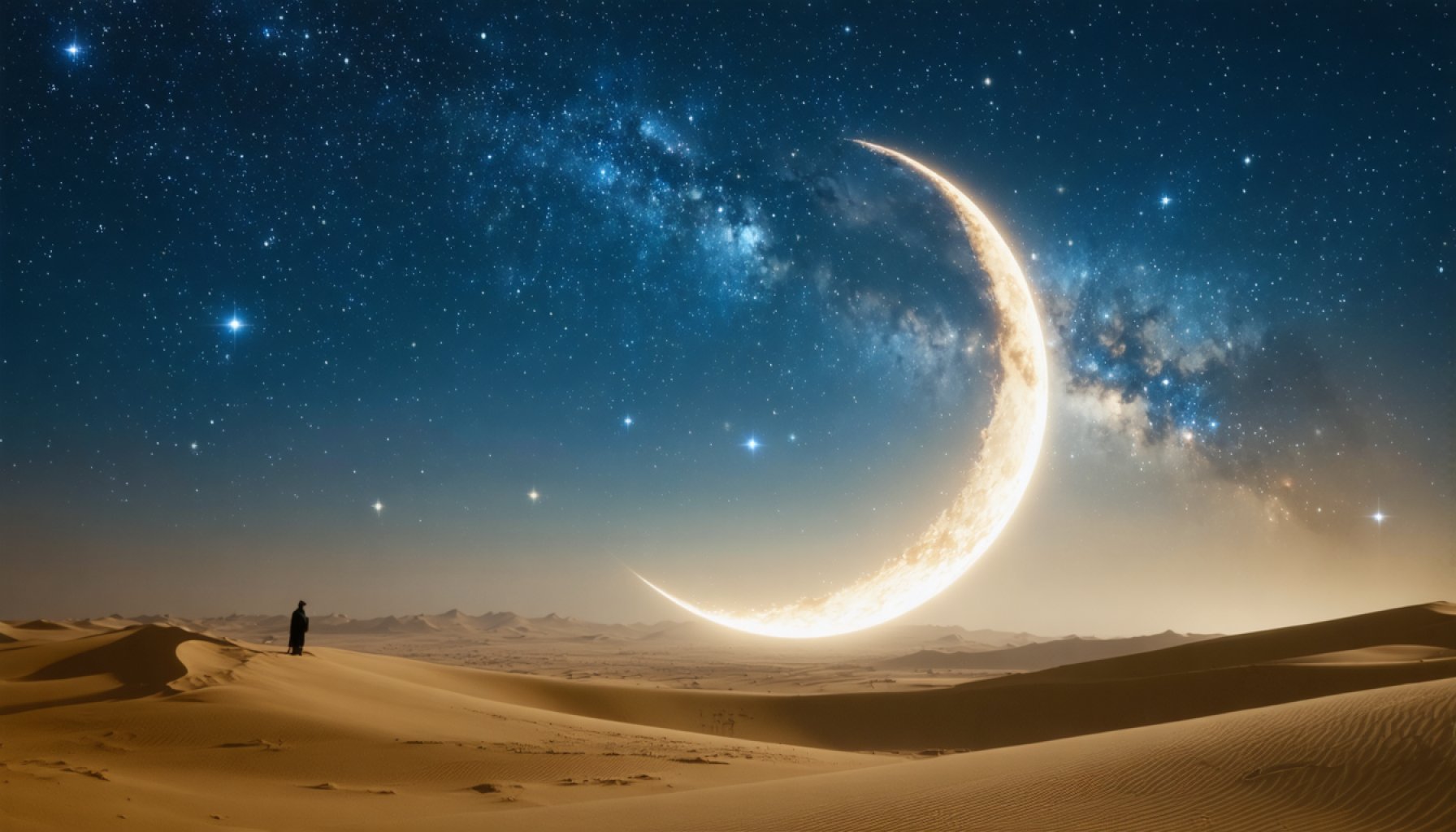- Saudi Arabia’s observatories focus on spotting the Shawwal crescent to end Ramadan and start Eidul Fitr.
- The Tumair observatory anticipates a brief 7 to 8-minute visibility of the crescent shortly after sunset.
- The Shawwal crescent remains unseen after sunset on March 29, 2025, due to its setting before the sun.
- An eclipse on the same day partially obscures the sun, but the crescent remains hidden.
- March 31 is set as the date for Eidul Fitr, based on astronomical calculations and a full 30-day Ramadan.
- Different regions may celebrate Eid on varying dates due to differences in sighting practices and scientific forecasts.
As the sun dips below the western horizon, a celestial ballet ensues in Saudi Arabia. Ten meticulous observatories are poised, telescopes trained on the heavens, in anticipation of a fleeting crescent that will signal the end of Ramadan and the joyous onset of Eidul Fitr. This elusive crescent, the Shawwal moon, ignites excitement and meticulous calculation across the kingdom.
Consider the Tumair observatory, where the atmosphere buzzes with anticipation. Experts forecast the brief apparition of the crescent — a mere 7 to 8-minute performance in the sky. As the clock ticks towards sunset at 6:11 PM, all eyes remain unwavering. The moon offers its brief spectacle shortly after, courting the horizon as clear skies and a comfortable 32°C create ideal viewing conditions.
Across the region, the International Astronomy Center punctuates the sky with a dramatic solar event. A partial eclipse on March 29 casts shadows over the western Arab world, a celestial spectacle that momentarily obscures up to 94% of the sun. Yet amidst this cosmic drama, one crucial fact emerges: the Shawwal crescent remains hidden from view that evening. The moon sets its course before the sun descends, rendering the conjunction post-sunset and thwarting visible confirmation of the new lunar month.
Emirati astronomer Ibrahim Al-Jarwan, a prominent figure in the astronomical community, elucidates this celestial puzzle. His calculations, rooted in precise astronomical data, affirm that the Shawwal crescent will remain unseen after sunset on March 29, 2025. Consequently, the Emirates Astronomy Society aligns with the scientific consensus, postulating that Ramadan will fulfill its 30-day journey, making March 31 a definitive marker for Eid celebrations.
In a world where tradition and science intertwine, regions adhere to varying practices. While some nations will rely on observed sightings to decree Eid, others will embrace scientific forecasts, leading to fluctuating festival dates. For those entrusting the moon’s presence above all, the revelry of Eidul Fitr shall grace the world on March 31. Meanwhile, others may allow the tides of tradition to whisper the dawn of celebration a day earlier, on March 30.
This celestial interplay underscores a broader truth — the dance of the cosmos wields profound influence over earthly customs. The chase for the Shawwal crescent, steeped in tradition and bolstered by science, encapsulates the harmonious dance between the stars and humanity’s enduring passage through time.
The Celestial Dance: Unlocking Secrets of the Shawwal Crescent and Eidul Fitr
Exploring the Cultural and Astronomical Significance of the Shawwal Crescent
In Saudi Arabia, and throughout the Islamic world, the sighting of the Shawwal moon marks the end of Ramadan and heralds the beginning of Eidul Fitr, a festival characterized by joy, reflection, and gratitude. This profound event is deeply rooted in religious tradition and is a testament to the intricate interplay between celestial movements and cultural practices.
How the Shawwal Moon Sighting Works
1. Preparatory Measures:
– Timing: Observatories are set up across Saudi Arabia and other regions a few hours before sunset, as the appearance of the crescent moon is best viewed shortly after.
– Technology and Tools: Modern telescopes and sophisticated astronomical software are used to predict and capture the fleeting crescent, especially when weather conditions might obscure visibility.
2. The Sighting Process:
– The Role of Experts: Astronomers and volunteers participate in this event, often accompanied by religious leaders to validate the sighting according to Islamic calendars.
– Calculation and Observation: Despite calculations predicting the potential visibility of the crescent, actual sighting is essential. For such precision, atmospheric clarity and minimal light pollution are critical.
Significance of the Shawwal Crescent in Islamic Tradition
The Shawwal moon sighting is not only a scientific event but also bears immense cultural and religious importance. For Muslims, Eidul Fitr is a time of community, charity, and breaking of the fast, bringing societal unity after a month of reflection during Ramadan.
Insights and Predictions: The Challenges of Moon Sighting
– Scientific Significance: The role of astronomy is paramount in understanding lunar cycles and predicting future occurrences of Eid. This science helps reconcile discrepancies when traditional sighting might not be possible due to weather or environmental obstacles.
– Cultural Variability: Given regional climatic differences, communities in different parts of the world may have varying sighting practices. This sometimes results in Eid being celebrated on differing days, underscoring the diversity within the global Muslim community.
Real-World Applications and Recommendations
– Astronomical Calculations: Utilizing advanced software for astronomical calculations can aid religious authorities and observatories in making more accurate predictions about the moon’s visibility.
– Promotion of Scientific Literacy: Encouraging communities to understand and appreciate the astronomical workings behind such religious events can enhance engagement with scientific disciplines.
– Building Global Awareness: Efforts to educate the global Muslim diaspora about differing regional practices can improve cultural understanding and mutual respect.
Quick Tips for Observers
– Join Local Observatories: Participating in local moon sighting programs can bolster community ties and enhance personal understanding of lunar physics.
– Embrace Technology: Use apps and online platforms that predict moon phases and viewing conditions, like Time and Date, to keep informed about celestial events.
Conclusion
The tradition of moon sighting for marking Eidul Fitr reinforces the intersection of faith and science. As humanity advances in astronomical understanding, these practices serve as profound reminders of our connection to the cosmos, fostering greater appreciation for both ancient traditions and modern advancements.
